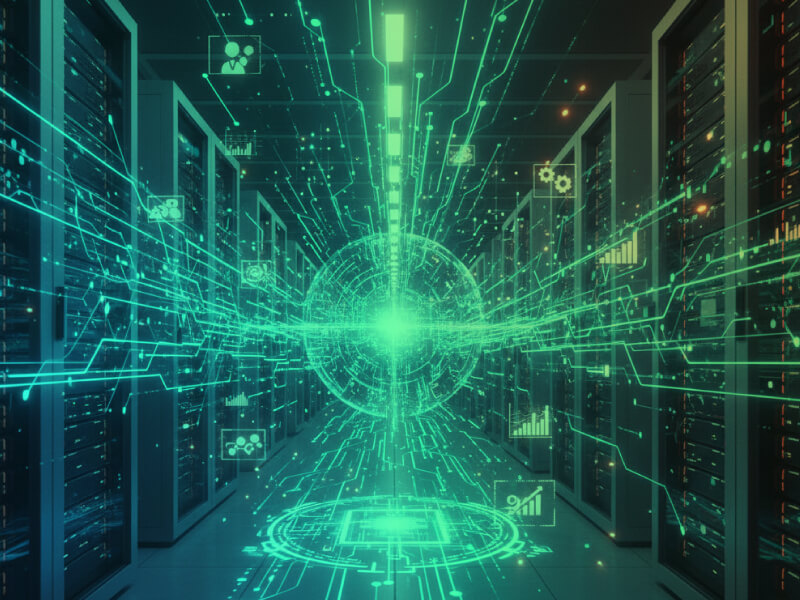AI is here to stay- What it Means for your Career

“The question is not whether AI will change the working world, but it’s how you will change with it.”
We have already started to feel a shift in the air. When we hear about generative AI, large language models, automation, and “AI-first” strategies are being adopted by companies everywhere, it’s a transformation that’s ongoing. Rather than resisting it, one should make a smart move to lean in
The Reality Check: AI Is Already Reshaping the Job Landscape
1. Layoffs and job shifts tied to AI:
Stories about layoffs provide the impression that there is a generalized downturn, but when we look into it closely, it reveals that AI and automation are playing a direct role in certain job cuts.
- So far this year, more than 17000 have been tied directly to AI-related responsibilities being structured or eliminated.
- Over the first half of 2025, 77,999 tech job losses in the US were directly linked to AI exposures or transformations.
- In total, for the year through September, U.S. employers have announced around 946,426 job cuts, the highest year-to-date tally since 2020, with a substantive share attributed to “technological updates / AI.”
- Since 2023, over 27,000 job cuts have been directly tied to AI’s adoption across roles.
These numbers tell an important perspective: AI is actively influencing career decisions today.

2. Shifting to Roles that Matters:
As AI tools integrate more in organizations, they make an evolution of which skills humans contribute. A recent study on online labor markets shows that the demand and supply of human resources in domains closer to text generation or simple programming, have been contracted, on the other hand tasks which requires domain knowledge, judgement, or orchestration are growing more complex.
As per Indeed’s insights, roles like software engineers, QA engineers, product managers, and project managers are among the one which are seeing reduction in demand in AI-led organizations, while roles which emphasizes on cybersecurity, data analytics, and AI? ML specializations are gaining traction.
So the question is not that “Will AI replace one’s job” but it’s “Which version of one would be relevant in an AI-powered world?”
The Opportunity: Why AI Means New Opportunities

Let’s change the narrative: AI is also creating enormous opportunities for those who adapt.
1. Demand is emerging for AI-savvy talent
- Companies will increasingly seek of individuals who understands how to use AI tools, design, fine-tune, integrate, audit and govern them
- Roles in data engineering, AI/ML modeling, prompt engineering, AI ethics & policy, AI operations (MLOps), and domain-specific AI application design are rising.
- In non-technical jobs, like marketing, HR, operations, sales, AI augmentation is becoming part of the job that of professionals who understand AI workflows and tools to get an edge.

2. Upskilling becomes a differentiator
In the upcoming years, one’s ability to learn new AI-related skills, pivot roles, and work alongside AI agents will matter more than traditional credentials.
A few upskilling tracks that one can consider:
| Track | Core Skills/Topics | Why It Helps |
| Data & Analytics | SQL, data pipelines, ETL, data visualization, AI-ready datasets | AI systems need clean, structured data and someone to manage that |
| Machine Learning / Deep Learning | Model architecture, training, fine-tuning, validation, explainability | Powers the “intelligence” behind many tools |
| Prompt Engineering / LLM Orchestration | Efficient prompt design, chaining tasks, human-in-the-loop flows | Many AI systems depend on layered prompts |
| MLOps / AI Ops | Deployment, monitoring, version control, model drift, scalability | Ensures AI systems run reliably in production |
| AI Ethics & Governance | Bias mitigation, interpretability, regulation, security for AI | As AI saturates industries, regulating it becomes crucial |
| Domain-Specific AI Integration | AI in healthcare, logistics, e-commerce, supply chain, etc. | The competitive edge is often domain + AI together |
3. The human–AI synergy is real
Many AI systems are designed to augment human performance, like taking over repetitive tasks or low-skill tasks so that humans can focus on higher value judgement, creativity and oversight.
Employees who can co-pilot with AI, by knowing what tasks to hand off, when to intervene, and how to guide the systems, will become more valuable.
“For the ones who are prepared, AI can add as a multiplier and not a replacement”
How You Can Leverage AI in Your Everyday Work
Today, AI is a productivity layer for engineers, developers, and IT professionals. AI tools are reshaping how technical teams deliver work faster and smarter, be it from code generation and testing to data analysis and system monitoring.
Here are some of the ways professionals can use AI in their day-to-day activities:
- Coding & Development: Using GitHub Copilot, Replit Ghostwriter, or ChatGPT Code Interpreter for faster prototyping, debugging, and documentation.
- Testing & QA: Tools like Testim.io, Mabl, and Codeium generate test cases and automate validation.
- DevOps & MLOps: AWS CodeWhisperer, Azure ML Studio, and Weights & Biases assist in deployment, model tracking, and CI/CD workflows.
- Data Engineering: Databricks AI, Snowflake Cortex, and Power BI Copilot simplify pipeline monitoring, queries, and dashboard generation.
- Research & Knowledge Work: Perplexity.ai, ChatGPT, or Claude.ai help synthesize technical research or architecture summaries.
- Automation & Workflow Integration: Zapier, Make (Integromat), and n8n automate cross-platform actions.
- Documentation & Reporting: Notion AI and Confluence AI help generate clear internal documentation or release notes.
- Content & Communication: Drafting emails, proposals, and reports using tools like ChatGPT, Jasper, or Notion AI.
Top 10 AI tools that professionals can use:
|
Category |
Tools |
Use Case |
| Coding Assistant | GitHub Copilot / Codeium | Code suggestions, debugging, and documentation |
| MLOps & Deployment | Weights & Biases / AWS SageMaker | Model tracking, monitoring, and deployment |
| DevOps Automation | Azure ML Studio / Jenkins with AI Plugins | Intelligent CI/CD pipelines and monitoring |
| Data Engineering | Databricks AI / Snowflake Cortex | Data preparation, pipeline optimization |
| Analytics | Power BI Copilot / Tableau GPT | Automated dashboards and insights |
| Testing | Testim.io / Mabl | AI-driven automated testing |
| Knowledge & Research | Perplexity.ai / ChatGPT | Technical research, API examples, summarization |
| Workflow Automation | Zapier / n8n | Integration across cloud platforms |
| Documentation | Notion AI / Confluence AI | Writing and summarizing technical docs |
| Collaboration | Microsoft 365 Copilot / Slack GPT | AI-driven meetings, summaries, and project updates |
One can start small, by picking up two or three tools which fit their daily tasks and integrating them in the workflow. For tech professionals, the goal is to use AI as a co-pilot for speed, accuracy, and focus on higher-value engineering challenges.
How Job Seekers & Current Employees Should Think Differently
Here are strategic mindsets and actions to adopt:
- While niche expertise can be powerful, avoid specializing in something that may become automatable or obsolete. Balance depth with adaptability.
- Attend AI-related meetups, webinars, and contribute to communities. Get exposure to what problems people are solving now.
JRD Systems: A Partner in AI Transformation & Upskilling
-
Training & internal reskilling:
We invest in our people through structured AI and analytics training programs, certifications, and hands-on mentorship. Team members get the chance to work directly with AI tools and projects, not just read about them. -
Project-based learning:
AI integration thrives on experimentation like pilots, proofs-of-concept, and real-world rollouts. Through active participation, our teams gain experience that goes far beyond theory, learning how to apply AI to solve business challenges. -
Shift in job scope:
As AI becomes part of daily operations, roles evolve. Team members are exploring new responsibilities from curating datasets and monitoring AI outputs to shaping model feedback loops. These experiences bring opportunities in advanced roles in data science, ML Ops, and AI product development. -
Visibility of AI value:
By implementing AI across logistics, operations, and supply chain systems, employees witness its tangible business value. This understanding builds confidence, helping them speak about impact.
What Career Paths Are Promising in the AI Era?
1. AI / ML Engineer / Researcher
-
Growth path:
Model development, domain-specific model fine-tuning, research or innovation teams.
2. MLOps / AI Ops Engineer
-
Growth path:
Model deployment, monitoring, drift detection, scaling in production.
3. Prompt Engineer / LLM Orchestrator
-
Growth path:
Designing prompt pipelines, chaining LLMs, and human-in-loop workflows.
4. AI Product Manager / Solution Architect
-
Growth path:
Leading AI-enabled product design, integrating AI features, balancing trade-offs.
5. AI Ethics / Governance / AI Audit
-
Growth path:
Oversight of AI systems, bias mitigation, audit trails, and governance frameworks.
6. Domain + AI Specialist
-
Growth path:
Designing AI applications tailored to your domain (for instance, JRD does this in logistics).
Conclusion
- Roles where human judgment, creativity, and oversight co-exist with AI can be seen more.
- One can build smarter, more efficient systems with AI as your co-pilot.
- One can shape AI’s direction, designing systems that are ethical, robust, explainable, and human-centric.
It’s true that there is a revolution ahead, but it will create paths for the ones who choose to learn, adapt, and act.
- Home
- What We Do
-
-
What We Do
We help our clients stay ahead in fast-paced, competitive markets by prioritizing personalized services that maximize impact.
Industry
-
-
- Partners
- About Us
- Resources
- Careers
